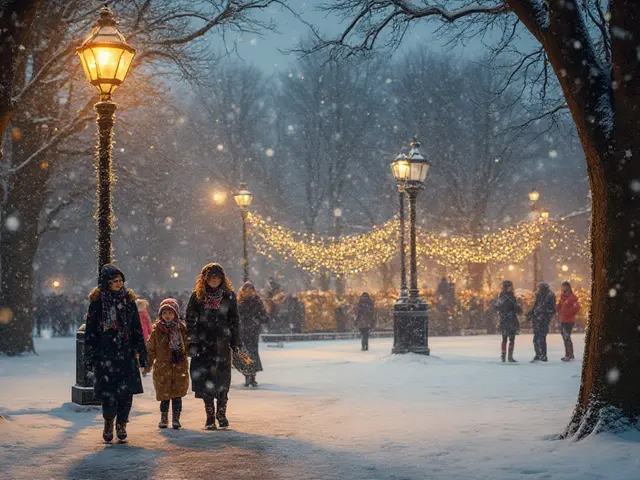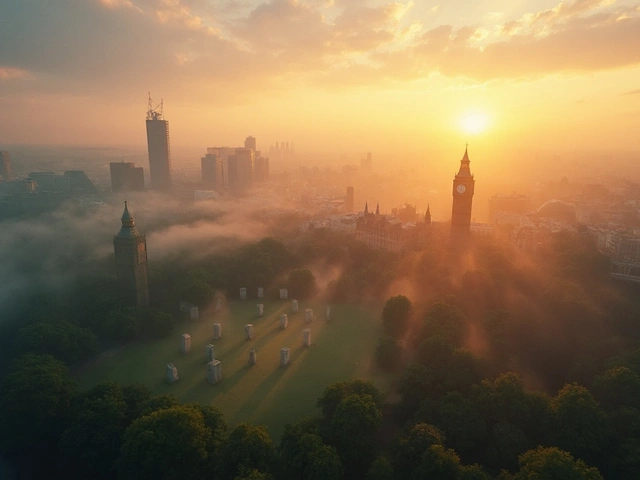Trying to pin down what makes London special? Start with the skyline. Whether you've lived here for decades or you're just getting off the train at King's Cross, London's iconic buildings are always ready to steal the show. Think about the first time you spotted the Gherkin or walked over Tower Bridge—it's impossible not to be impressed.
Everybody knows the Shard cuts into the clouds, and St. Paul’s Cathedral stands steady through centuries, but there’s more to these places than snapping a photo. London’s landmarks tell the city’s story, from hidden timelines in Westminster Abbey to the sneaky foxes patrolling around the Royal Albert Hall after dark. No matter where you are—north or south of the river—there’s a bit of jaw-dropping architecture waiting to surprise you.
If you’re a Londoner, you probably pass these buildings every day. But have you ever actually gone inside, or checked out the view from nearby Primrose Hill or the Sky Garden? Sometimes, it’s about seeing your own city with fresh eyes. For visitors, knowing when to dodge queues at the London Eye, or how to get the best angle of the Houses of Parliament at sunset, changes your whole experience.
- London’s Best-Loved Landmarks
- Hidden Architectural Gems Around the City
- Traditions and Stories Behind the Facades
- Tips for Exploring London’s Sights
- Building Your Own London Bucket List
London’s Best-Loved Landmarks
If there’s anything you’ve got to tick off in London, it’s the iconic buildings everyone goes on about. Some names just stand out worldwide: Buckingham Palace means British tradition at its best. While the Changing of the Guard ceremony is a crowd magnet, you don’t need to be royalty-obsessed to appreciate the palace’s size—over 775 rooms, and it’s where state visits actually happen. Best time to see less crowd? Try a weekday morning before 10am.
Walk down the river and there’s the unmistakable outline of Tower Bridge. It’s not just a pretty background for your selfie—its glass walkway is a thrill, and you can actually watch the bridge lift about 800 times a year to let boats pass. Check the bridge lift schedule online before visiting if you want to catch it in action.
Then there’s the Shard, poking up 310 meters over London Bridge station. The View from The Shard isn’t cheap, but it’s unbeatable for a clear day. There are actually three different restaurants at the top if you want to make a meal of it (Aqua Shard is a local favourite for brunch). Want a free panoramic view instead? The Sky Garden on Fenchurch Street gives you 360-degree city views for the price of booking online in advance—no ticket needed if you’re quick with the slots.
Let’s not forget St. Paul’s Cathedral. The dome was the tallest structure in London for over 250 years. Inside, the Whispering Gallery works like magic—say something against the wall, and you’ll be heard perfectly on the other side. And if you can manage the 528 steps to the Golden Gallery, you get a view that’s hard to beat.
| Landmark | Year Finished | Main Feature | Entry |
|---|---|---|---|
| Buckingham Palace | 1837 | Official residence of the monarch | State Rooms open in summer, admission fees apply |
| Tower Bridge | 1894 | Raising bascules/glass walkways | Paid entry for engine rooms & walkways |
| The Shard | 2012 | Tallest building in UK, viewing platform | Tickets needed; advanced booking advised |
| St. Paul’s Cathedral | 1710 | Famous dome, Whispering Gallery | Admission required for tours; service entry is free |
Each of these spots is easy to reach on the Tube. Just check for off-peak travel times to dodge the busiest crowds—weekdays before lunch or after 4pm are usually your best bet. If you’re after the classic postcard shot, stroll along South Bank at sunset or head to Westminster Bridge for the Houses of Parliament lit up after dark.
Hidden Architectural Gems Around the City
Everyone knows the big names—The Shard, Big Ben, the London Eye—but hidden all over London are buildings with just as much wow factor, minus the crowds. If you’re tired of squeezing through tourists in Westminster, it’s time to check out some lesser-known spots that locals love.
Take the Seven Noses of Soho, for example. These quirky sculptures are tucked on historic buildings across the West End, a playful piece of street art history made by artist Rick Buckley in the 1990s. It’s almost a rite of passage for Londoners to spot them on a night out.
Another one—Fitzrovia Chapel, hidden behind busy offices between Goodge Street and Oxford Circus. Step inside and you’re hit with gold mosaics and marble. It’s tiny, but stunning, and open to the public on Wednesdays or during special art exhibitions. Not long ago, the Guardian described the chapel as “London’s most surprising sanctuary.”
Then there’s the Grade I-listed Wilton’s Music Hall in Whitechapel—Britain’s oldest surviving music hall, tucked away down a cobbled alley. Book a behind-the-scenes tour to see Victorian architecture and learn about secret tunnels once used by performers. The vibe here is nothing like a West End theatre, but every bit as memorable.
You can also spot 1930s modernism at the Isokon Building in Hampstead, which once hosted famous Bauhaus émigrés. It’s not just pretty—there’s a free exhibition in the former garage telling the stories behind the place. Or grab a coffee at the Brunel Museum’s rooftop garden above the Thames Tunnel, a spot most tourists walk right past.
"You can walk past hidden treasures every day in London and not realise it unless you look up, or take a turn off your usual route," says Blue Badge guide and local historian, Ian McLaren.
To help you track down these gems, here are a few tips:
- Follow The London Society for architectural walks and pop-up events
- Keep an eye on Open House Festival in September—loads of places open their doors for free
- Check @LookUpLondon on Instagram for unusual finds every week
- Download the Hidden London app to hunt for secret spots on your lunch break
For a bit of trivia, have a look at these numbers:
| Hidden Gem | Year Built | Entry Fee | Closest Tube Stop |
|---|---|---|---|
| Fitzrovia Chapel | 1891 | Free | Goodge Street |
| Wilton’s Music Hall | 1859 | Tours from £8 | Tower Hill |
| Isokon Building | 1934 | Free | Belsize Park |
| Seven Noses of Soho | 1997 | Free | Tottenham Court Road/Oxford Circus |
Don’t just stick to the mega-famous London attractions. These gems aren’t just for architects or hipsters—they’re for everyone who loves a cheeky discovery on their lunch break.
Traditions and Stories Behind the Facades
There’s always a story hiding behind London’s stone and glass. Take the Tower of London—locals love sharing the bit about the ravens. According to superstition, if the ravens ever leave, the whole kingdom will fall. Guy the Raven even had his own pension after retiring. You won’t find that on most tourist boards.
The daily Changing of the Guard at Buckingham Palace isn’t just for tourists with selfie sticks. It’s a real tradition, nicked straight from centuries of royal protocol, happening almost every day at 11:00 am. Want to feel like an insider? Show up 15 minutes early to score a decent spot near the Victoria Memorial.
St. Paul’s Cathedral has seen everything from royal weddings to World War II bombings. People say its legendary dome survived the Blitz by sheer luck and the grit of fire-watchers camped on the roof. School kids on field trips still get told about Winston Churchill demanding St. Paul’s be saved at all costs, just to keep up British morale.
London’s most popular iconic buildings have their quirks too. The Shard was once dismissed as “a glass splinter” by critics, but locals now use it as a reference point to navigate the city. And on New Year’s Eve, thousands gather along the Thames, hoping to catch the fireworks framed between its floors.
If you visit Smithfield Market, you’re stepping into the shoes of generations of Londoners; meat has been traded there since the Middle Ages. Traders still roll in before sunrise, and the market’s annual Christmas Eve ‘pie competition’ draws in local butchers, chefs, and regulars with serious pride.
| Landmark | Key Tradition or Story | First Recorded |
|---|---|---|
| Tower of London | Ravens' legend and Yeoman Warders (Beefeaters) | Late 1600s |
| Buckingham Palace | Changing of the Guard | 1837 |
| St. Paul’s Cathedral | Saved during the Blitz, iconic dome survives | 1940s |
| Smithfield Market | Christmas Pie Competition | Early 1800s |
If you start digging, there’s a wild mix of legend and real history built into every corner. These stories aren’t just museum pieces—they’re alive right now, shaping the way Londoners see their city and celebrate its weird and wonderful past.
Tips for Exploring London’s Sights
You can stare at London’s skyline from a distance, but actually getting the best out of these iconic buildings takes a bit of strategy. Peak visiting times are real—if you turn up at the Tower of London or Buckingham Palace just before noon on a Saturday, expect long queues. Go early on a weekday instead, and you’ll beat the crowds and the noise.
Transport makes or breaks your day. Most landmarks sit close to a Tube stop—think Westminster for Big Ben or London Bridge for the Shard—but don’t ignore buses. The No. 11 bus, for example, passes through landmarks like St. Paul’s Cathedral and Trafalgar Square for just a couple of quid, and you can hop off at your fav Building. It’s a cheap sightseeing tour minus the selfie sticks and guides yelling into megaphones.
Some sights are best enjoyed for free. You don’t need to fork out for the London Eye to get a panoramic city view—the Sky Garden is free, you just need to book ahead online. Primrose Hill, Parliament Hill, and Greenwich Park also offer killer views, and you only need comfy shoes and maybe a coffee from a local café. Pro tip: Sunset from Waterloo Bridge is tough to beat.
Many buildings hide their best features. Westminster Abbey runs Evensong services most evenings—all free—and you get to listen to world-class choral music while soaking in the architecture. St. Paul’s has secret whispering galleries and the British Museum’s Great Court is just as impressive as its artefacts. Don’t just hover outside—step inside if it’s open.
- Book tickets online when you can. It’s usually cheaper and saves you a tonne of time at places like the London Eye and Tower Bridge.
- Double-check opening hours. Some sites—especially churches or private buildings—close early or for special events.
- Want a quiet moment? Go right after opening or at the tail end of the day. Tour groups usually pack up by 4pm.
- If you’re taking photos, mornings have softer light and fewer photobombers.
- Download free audio guides from official websites. You’ll get more out of your visit without following a big tour group.
If you’re local, don’t just stick to the obvious. Buildings like the Leadenhall Building (the Cheesegrater) have public spaces, and the Barbican’s brutalist nooks are worth a wander. And those secret city pubs often hide centuries-old cellars—combining old-world charm with a pint or two.
Building Your Own London Bucket List
If you want to get the most out of London, having a bucket list is a smart move—there's so much happening that it's easy to miss the best bits. Tourists often rush straight for the attractions, but locals know timing, shortcuts, and lesser-known spots. Here’s how you can build a proper London bucket list that feels like your own.
- Start with the headliners—charge up the camera and visit the iconic buildings that anchor the city's image. Think: the Tower of London (get there early to beat the queues), Buckingham Palace (best photos during Changing the Guard), and the Shard’s lofty viewing platform.
- Add places outside central London. Hampton Court Palace, with its outdoor maze, and Alexandra Palace, nicknamed "Ally Pally" by locals, both offer killer views and unique histories.
- If you love modern architecture, don’t leave out the Barbican for its brutalist vibes or the Leadenhall Building (the Cheesegrater) with its eye-catching angles.
- Pop cultural stops belong on your list too. Abbey Road’s zebra crossing, Shakespeare’s Globe, or the Harry Potter filming sites give anyone a story to tell back home.
- Get practical—plan your visits for off-peak hours, check out free days at museums like the V&A, or use the Thames Clippers for a sightseeing cruise that costs less than most tourist boats.
Here’s a handy table to compare top London attractions:
| Location | Best Time to Visit | Entry Fee | Fun Fact |
|---|---|---|---|
| Tower of London | Early morning | £33.60 (adult) | Home to the Crown Jewels |
| The Shard | Weekday afternoons | £32 | Tallest building in the UK |
| Buckingham Palace | During Changing the Guard | £32.50 (summer tours) | Over 775 rooms inside |
| St Paul's Cathedral | Late afternoon | £23 | Whispering Gallery has famous acoustics |
| Sky Garden | Morning slots | Free (book ahead) | Palm trees with a skyline view |
Update your list as you go. London’s always changing, and something new always pops up—a rooftop, a pop-up art show, or a quirky neighbourhood event (Notting Hill Carnival and the London Design Festival are crowd-pleasers).
If you’re into apps, check out “Visit London” or “London Architecture Guide” to help plan your route and find up-to-date info on events. And ask Londoners—the best tips usually come from someone who’s already found a hidden gem.




